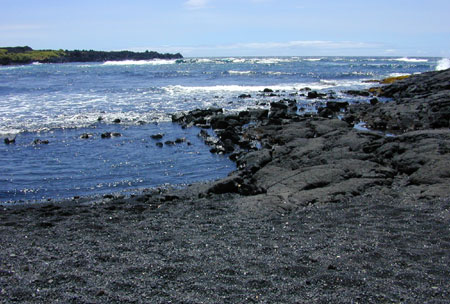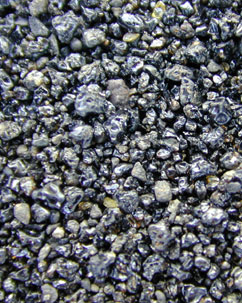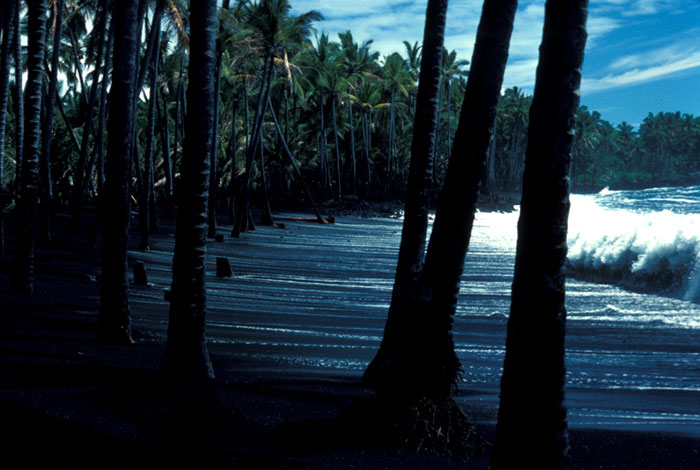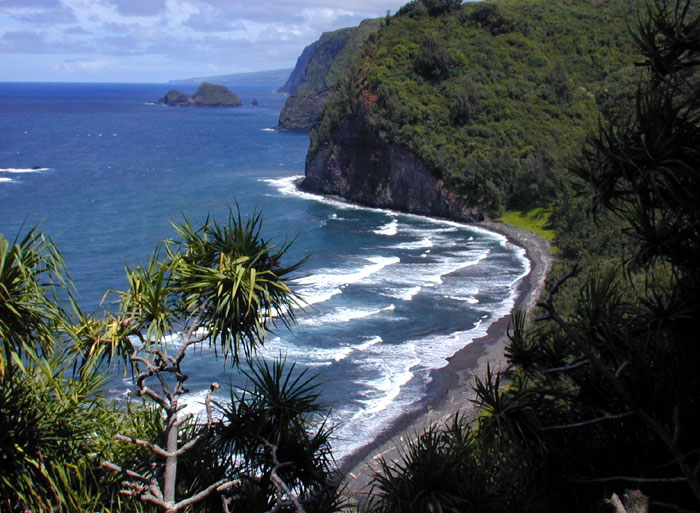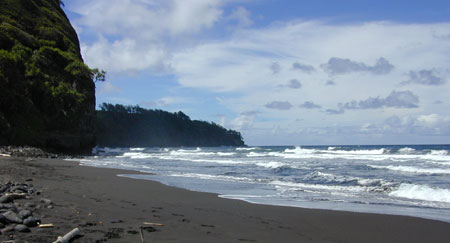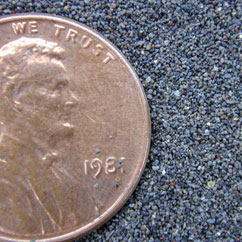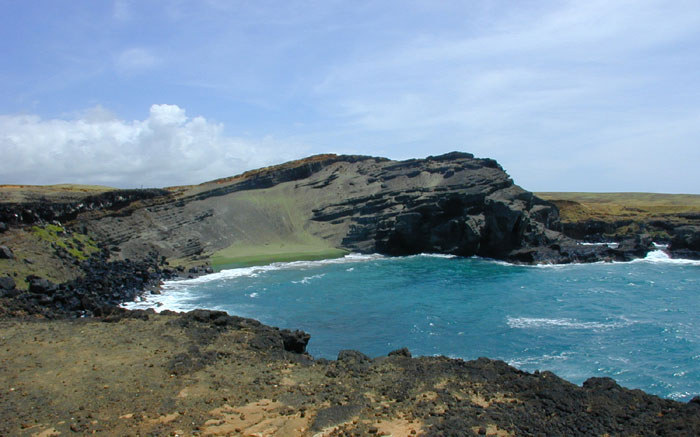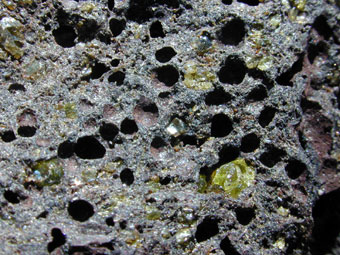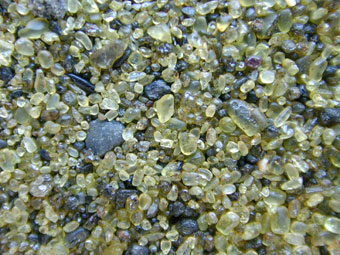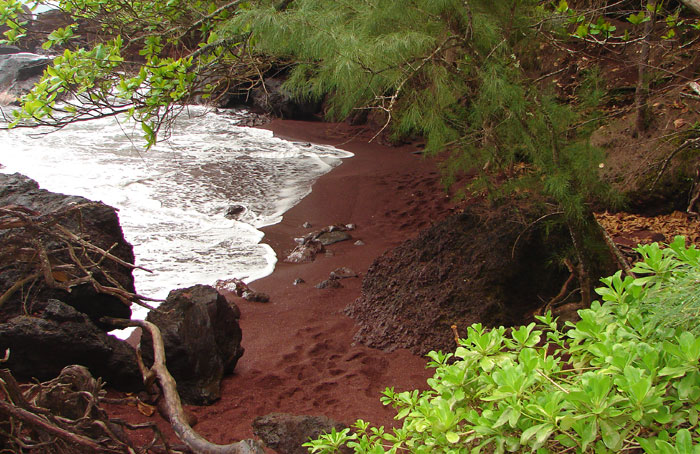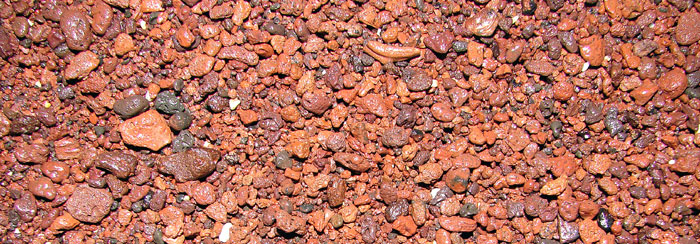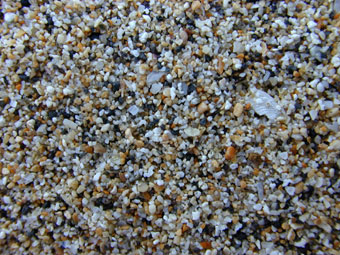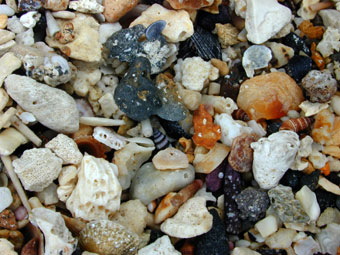An artist's diagram of a cross sectional view of Hawaii. (LJF image)
|
Hawaii is geologically a unique place on Earth because it is caused by a 'hot spot.' Most islands are found at tectonic plate boundaries either from spreading centers (like Iceland) or from subduction zones (like the Aleutian Islands). There are few 'hot spots' on Earth and the one under Hawaii is right in the middle of one of the largest crustal plates on Earth - the Pacific Plate. A geologic 'hot spot' is an area in the middle of a crustal plate where volcanism occurs. It is easy to geologically explain the volcanism at plate spreading centers and subduction zones but not as easy to explain a 'hot spot.' The molten magma breaks through the crustal plate (theories describe this as either from a weak/thin part of the plate or a particularly hot part of the molten magma). A hot spot under the American plate is why Yellowstone National Park has geysers and other thermal features. If the hot spot is under the seafloor (as it is in Hawaii) it produces undersea volcanoes. Some of these volcanoes build up to the surface of the ocean and become islands. Over millions of years the plate may move across the 'hot spot' and the original volcano become extinct but a new volcano will begin to form in the area of the 'hot spot.'
|
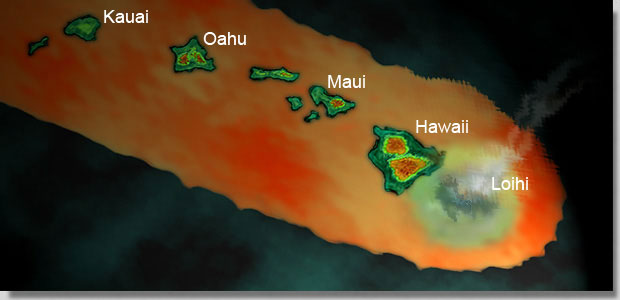
|
A bird's eye view of Hawaii from an artists's perspective. (LJF image)
|
The northwest moving Pacific Plate has moved across the 'hot spot' that created the Hawaiian Islands for millions of years. This movement has left the northwest trending island chain (of over 20 islands and atolls) we call Hawaii. As islands move northwest, away from the 'hot spot,' they begin to erode and become volcanically inactive. Over time the island may erode so much it is no longer an island but an underwater seamount. Kauai is the oldest of the main Hawaiian Islands now, having formed some 5 million years ago, with its volcano considered to be extinct and fully in the process of erosion. Oahu is next, its volcanism is considered to be inactive. Then Maui with its Haleakala crater that could still come to life one more time. And the youngest island is the 'Big Island' of Hawaii itself, with surface lavas all less than one million years old. It still has active volcanism. On the seafloor 20 miles to the southeast of Hawaii is an active volcanic area with periodic eruptions. This area is called Loihi and will be the site of the next Hawaiian Island if geologic processes continue as they have for millions of years but it may be over 10,000 years before this happens.
|
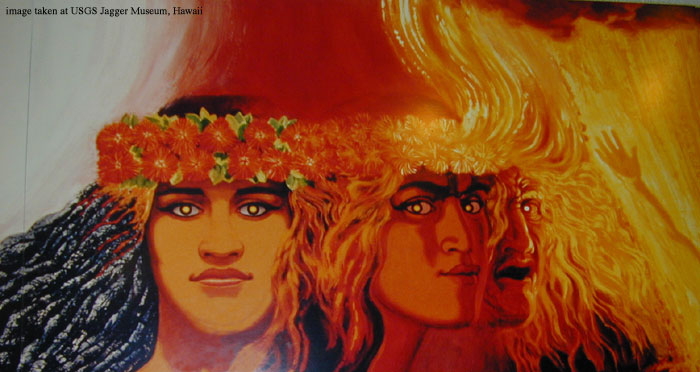
|
Pele, goddess of fire, as portrayed in a mural at the Jagger Museum on the rim of Kilauea.
Map of the five volcanos that made the big island of Hawaii (left). Steam vents (Volcano House is in the background where tourists eat and stay) and sulfur deposits near the rim of Kilauea volcano (right). (GA images)
Kilauea volcano is active on its flanks today. Inside the volcano is Halema'uma'u, a pit crater inside the larger Kilauea crater, in the background of this image taken in 1976 when Halema'uma'u was not active. (GA image)
Sulfur Banks is an area near the visitor center at the rim of Kilauea volcano (left). Closeup of the sulfur deposits reveal beautiful crystals (right). (GA images)
|
Hawaii has active volcanism today. The big island of Hawaii is the largest of the current Hawaiian Islands and is made of five volcanoes (Kohala, Mauna Kea, Hualalai, Mauna Loa and Kilauea). Kohala last erupted 60,000 years ago and Mauna Kea last erupted 3,500 years ago. These two volcanoes are considered dormant. Hualalai's last eruption was in 1801. Only two of Hawaii's volcanoes are active today - Mauna Loa and Kiluaea. Mauna Loa erupted in 1984 and Kilauea is considered to be one of the most active volcanoes on Earth today. It has erupted over 30 times in the last 40 years. Hawaii is one of the few places on Earth where you can safely watch the volcanic processes that shape our Earth.
|
Cross sectional diagram of Kilauea volcano (from the Jagger Museum) showing the east rift zone (most active area today). (GA image)
Halema'uma'u, a pit crater, inside Kilauea Caldera started erupting in 2008 creating an almost constant plume of steam and volcanic gases (including sulphur dioxide). This caused Hawaii Volcano National Park to close part of its Crater Rim Drive (but there was still plenty to see inside the National Park). In fact, if you were at the National Park, prior to May 2018, after dark then Halema'uma'u crater was usually glowing red from a lava lake in the bottom of Halema'uma'u - best viewing was from the Jagger Museum. All this changed in May 2018. (GA image)
View of Halema'uma'u crater (inside Kilauea Caldera) as viewed from the Jagger Museum prior to the 2008 eruption (daytime left). At night, prior to the 2008 eruption, the lava lake in the bottom of Halema'uma'u reflected off the stream of volcanic gases (right). (GA images)
|
Kilauea volcano has active vents that erupt in various places on the southeastern side of Hawaii. The 'hot spot' volcanos are considered to be gentle volcanos and different than the violent volcanic eruption from Mount Saint Helens that killed many people in the State of Washington in 1980.
|
Pu'u O'o vent August 2002. (GA images)
Erupting vents inside Pu'u O'o vent. (GA image)
Lava flow through forest on the East Rift Zone of Kilauea. (GA image)
Burning trees due to new lava flow on East Rift Zone of Kilauea August 2002. (GA image)
|
Pu'u O'o vent became active in 1983 and was the primary source of surface lava until May 2018 in the east rift zone of Kilauea. It is about 10 miles east of Kilauea crater and far from most roads but helicopters could safely take you there for an aerial view. Over 60 separate eruptions came from Pu'u O'o both inside the National Park and on County property. These flows were sometimes on the surface where they covered subdivisions and sometimes in lava tubes that reached the ocean.
|
Helicopter view of lava flowing toward the ocean (left). Lava flowing into the ocean and a new black sand beach from East Rift Zone, Kilauea Volcano, August 2002 (right). (GA images)
Lava flow toward the ocean with steam (left). Crack in recent lava flow shows cooled surface but still molten layers under it (right). (GA images)
Warning sign near a recent surface lava flow reminds visitors that volcanism can be dangerous (left). Trail to recent lava flows in the National Park are sometimes marked with yellow tags to help visitors see the lava flows and remain safe (right). (GA images)
|
Lava flowing into the ocean is not a common sight but, in Hawaii, it can be possible for the general tourist to view this. Hawaii's lava is slow moving and somewhat predictable in its path. The Hawaii Volcanoes National Park sets up a marked trail and signs to guide tourists for the best views of the eruptions of Kiluaea while keeping them reasonably safe. Every day the situation with the location and activity level of the lava changes and park personnel are kept busy during active periods.
|
Lava Flows (GA images)
|
Lava flows from Pu'u O'o during the summer of 2004 (above) provided great viewing for anyone who was willing to walk about a mile along the marked path. The flows were active but at the speed of a slowly moving snail so viewing them was easy. Flowing lava may be over 2,000 degrees Fahrenheit with the air next to it close to 600 degrees. It is easy not to get too close to the flowing lava as you break out into a sweat when you are a few feet away. Usually the Trade Winds are blowing near the flowing lava which allows rather close safe inspection as the winds help to cool onlookers down a bit. Notice how the molten (red) lava that is flowing cools on the surface. This flow is distinctly pahoehoe (ropey) and it is easy to see how it forms.
|
Hawaiian shield volcano. (GA image)
|
Hawaii's volcanic eruptions are known for their gentleness and resulting shield volcanoes. Fountains and fissures do break out occassionally in the Hawaiian volcanos but these are not the norm.
|
Lava flow. (GA image)
New lava flow over a road in Hawaii Volcanoes National Park. (GA image)
Steam from new lava flow escapes - note yellow markers in background that mark a safe trail for tourists to view the recent lava flows. (GA image)
|
Magma turns to lava as molten rock comes to the surface. Molten rock is considered magma when it is under Earth's crust, but when extruded from the crust (as in a volcanic eruption) it is called lava. The lava flows through cracks, vents and fissures, adding to Hawaii's land mass.
|
Lava cliff from a recent lava flow. (GA image)
Fingers of pahoehoe lava seem to drip down the lava cliff (left). Pahoehoe flow over older, eroded, lava flow (right). (GA images)
Pahoehoe lava hardens into interesting textures. (GA images)
Closeup of glassy surface of new pahoehoe lava. (GA image)
|
Pahoehoe lava has a ropey texture.
|
Pahoehoe and aa lava flows (above). (GA image)
|
Aa lava has a rough and clinkery texture.
|
Aa lava flow (left). Closeup of aa lava (right). (GA images)
Dragon's teeth, Maui. (GA image)
|
Dragon's teeth (in Maui) is a unique lava flow that was influenced by high waves as the ancient lava flow hit the ocean. The wave energy at the time of the flowing lava was strong enough to curl up the edges of the lava before it cooled leaving these unique giant tooth-like structures.
|
Thurston Lava Tube is part of a trail in the Hawaii Volcanoes National Park (left). Visitors enter through a 'skylight' (collapsed roof of a lava tube), walk a ways through the tube and exit via another 'skylight.' A small lava tube (right) that was exposed on a recent flow. (GA images)
|
Lava tubes develop as the lava flows and hardens on the outside. The inside continues to flow and may drain out of the 'lava tube' entirely. Some of these lava tubes are small but some are very large (as much as 20 feet in diameter). Many of the lava tubes have a flat bottom as the lava hardened when it slowed down and remind some people of subway tunnels. When the top of a lava tube breaks through it is called a 'skylight.'
|
Tree molds below ground (left) and above ground (right). (GA images)
|
Tree molds form as lava flows around living trees. If the lava flow stays deep around the tree it will leave a below grade hole as the tree burns and dies. If the lava flow moves on through it will often leave standing tree molds that are hollow (as the tree burns and dies) but standing above grade because the flow went on past.
|
Helicopter view of lava flow over road (left). Closer helicopter view of lava over road and new shelf developing on the south shoreline of the big island of Hawaii (right). (GA images)
New south shoreline of Hawaii, August 2002, as seen from a helicopter. (GA image)
|
New acreage is formed in Hawaii when the lava flows make it to the edge of the island. Often this new acreage is just a shelf, with ocean water or rubble under the shelf so access to this new acreage is off-limits until it is cool and has been explored. If it is solid then it will be safe but if it is just a shelf (with water underneath) then it may break at any time. When the lava flow hits the ocean where there was a cliff before, there may be a step-like feature showing where the old sea cliff was located.
|
Ocean Entry 2016 Kamokuna. (GA image)
|
In 2016 the lava from Pu'u O'o traveled downhill for miles in lava tubes and reached the ocean where it spilled out along the shoreline creating a large cloud of steam and volcanic gas. This was near the southeast boundary of the National Park and county.
|
Lava Delta at Kamokuna. (GA image)
|
A large lava delta developed for about six months at Kamokuna as the lava emerged from 6-8 foot tall areas. Boat trips to this ocean entry provided excellent viewing.
|
Molten Lava and Salt Spray along the edge of the Delta. (GA image)
|
As each lava tube emptied into the ocean the resulting steam from super heated ocean water condensed on the solid black lava and left a white covering of salt. Boat operators were careful to stay only a short time near shore with the hot ocean to be sure not to overheat their boat engines.
|
|


